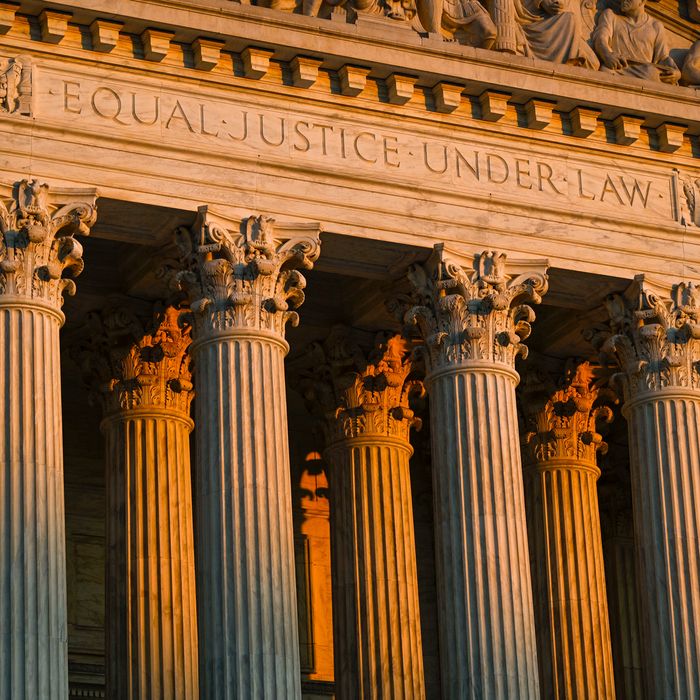
A surprise report from the Supreme Court on its investigation into who leaked a draft of the opinion overturning Roe v. Wade informs the public that the disclosure was “a grave assault on the judicial process,” an “extraordinary betrayal of trust,” and that the leaker “brazenly violated a system that was built fundamentally on trust.” The summary of the inquiry, conducted by the Court’s marshal, Gail Curley, provides a tiny window into the pandemic-era workings of one of the most secretive institutions in American life. It describes consulting cell-phone records and printer logs and conducting interviews that culminated in affidavits. We even learn that some of those interviewed breached protocol by blabbing to their spouses. But crucially, it does not tell you whether investigators actually spoke to the justices themselves. Oh, and the report also doesn’t say who leaked to Politico last spring. These omissions may or may not be related.
The report begins with an unsigned statement from the Court that says, “After months of diligent analysis of forensic evidence and interviews of almost 100 employees, the Marshal’s team determined that no further investigation was warranted with respect to many of the ‘82 employees [who] had access to electronic or hard copies of the draft opinion.’” The internal quote is from the marshal’s portion of the report, which never explicitly explains who counts as an “employee.” The marshal does say that “the investigation focused on Court personnel — temporary (law clerks) and permanent employees — who had or may have had access to the draft opinion during the period from the initial circulation until the publication by Politico.” Are the justices “permanent employees”? (Hard to get more permanent than a lifetime appointment, right?) Well, the marshal writes that “the investigators determined that in addition to the Justices [emphasis mine], 82 employees had access to electronic or hard copies of the draft opinion,” suggesting that the nine weren’t included in that count. I called and emailed the Court’s Public Information Office on Thursday afternoon, asking if the justices were interviewed or scrutinized — and, if they weren’t, why not.
More than 24 hours later, at 4:19 p.m. on Friday, the Supreme Court issued the following statement from Marshal Curley: “During the course of the investigation, I spoke with each of the Justices, several on multiple occasions. The Justices actively cooperated in this iterative process, asking questions and answering mine. I followed up on all credible leads, none of which implicated the Justices or their spouses. On this basis, I did not believe that it was necessary to ask the Justices to sign sworn affidavits.”
When Politico first published the draft, conservative legal activists pointed the finger at the left, even naming two clerks for liberal justices. (The report addresses the naming of law clerks and says “investigators found nothing to substantiate any of the social media allegations regarding the disclosure.”) In the many months since the leak, nothing has emerged implicating any liberal justices, who are dyed-in-the-wool institutionalists, nor has anyone satisfyingly explained why the leak was supposed to help the pro-choice side.
On the other hand, there are some morsels leading in the direction of the conservative justices. The claim that Chief Justice John Roberts was trying to peel off Brett Kavanaugh’s vote for an abortion compromise — later backed up by the actual, published opinions — appeared in an article by the conservative Wall Street Journal editorial board the week before the draft opinion leaked alongside urging the Republican appointees to stay strong against Roe. In November, the New York Times reported on an account from apostate anti-choicer the Reverend Rob Schenck that in 2014, Justice Samuel Alito or his wife told a couple of conservative donors over dinner that he wrote the opinion in Hobby Lobby, the decision undermining contraceptive insurance coverage, weeks before it was public. Alito didn’t deny the dinner but did say he and his wife never leaked anything. And yet Schenck was able to show contemporaneous emails indicating he somehow knew about the Hobby Lobby outcome before it was public.
If, as one theory went, the goal of the leak was for conservatives to corner Kavanaugh, preventing him from defecting to Roberts’s “moderate” alternative, it succeeded. Kavanaugh indeed voted to overturn Roe v. Wade, notwithstanding his separate opinion proclaiming himself a totally reasonable guy.
If you ever make the mistake of saying to a Supreme Court loyalist that the Court lacks transparency or is overly opaque in its workings, you’ll probably be lectured that, actually, unlike the other branches of government, the Court has to issue texts to explain the justices’ reasoning. The justices’ preface itself rehearses this argument: “To meet our obligations as judges, we accept submissions from parties and amici, we engage advocates at oral argument, and we publish explanations of our final decisions. All of this we do in the open.” But as the leak report underlines, this supposed openness only gets you so far. The justices themselves set the terms, and those terms make them untouchable. They don’t have press conferences to answer to reporters as to why they left out this or that precedent; they rarely open themselves up to unfiltered questioning at events, and if they do, little is gleaned. (Once, when I had the chance to ask Elena Kagan about the Obamacare leaks in 2012, she literally offered me a “talk to the hand.”) Sometimes you can read tea leaves in a particularly testy dissent. But generally, you’re lucky if you can get a late Friday-afternoon statement out of the press office.
This post has been updated to include the statement the Supreme Court issued on Friday.






























